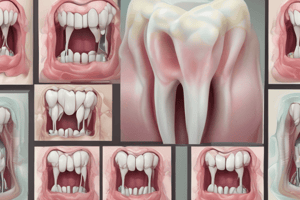Podcast
Questions and Answers
Which class of cavity involves the proximal surface of posterior teeth for restoration?
Which class of cavity involves the proximal surface of posterior teeth for restoration?
- Class I
- Class III
- Class IV
- Class II (correct)
What is the term for a wall that is internal and perpendicular to the long axis of the tooth?
What is the term for a wall that is internal and perpendicular to the long axis of the tooth?
- Axial wall
- Dentinal wall
- Enamel wall
- Pulpal wall (correct)
In cavity preparation, what is the definition of a line angle?
In cavity preparation, what is the definition of a line angle?
- A horizontal surface perpendicular to occlusal forces
- Junction of two planar surfaces of different orientation (correct)
- An external wall of the tooth
- Junction of three planal surfaces of different orientation
Which class of cavity restoration involves the proximal surface of anterior teeth and does not involve the incisal edge?
Which class of cavity restoration involves the proximal surface of anterior teeth and does not involve the incisal edge?
What defines a Class V cavity?
What defines a Class V cavity?
What is an axial wall in the context of tooth cavities?
What is an axial wall in the context of tooth cavities?
Which class of cavity restoration involves the incisal edge of anterior teeth?
Which class of cavity restoration involves the incisal edge of anterior teeth?
How many surfaces are involved in a Class I cavity?
How many surfaces are involved in a Class I cavity?
Flashcards
Cavity Preparation Angles
Cavity Preparation Angles
The junction of two prepared cavity walls and the external surface of the tooth.
Line Angle
Line Angle
A line angle is the junction of two planar surfaces of different orientation along a line.
Internal Line Angle
Internal Line Angle
An internal line angle's apex points into the tooth.
External Line Angle
External Line Angle
Signup and view all the flashcards
Point Angle
Point Angle
Signup and view all the flashcards
Class I Cavity
Class I Cavity
Signup and view all the flashcards
Class II Cavity
Class II Cavity
Signup and view all the flashcards
Class III Cavity
Class III Cavity
Signup and view all the flashcards
Study Notes
Cavity Definition
- A cavity is a defect in enamel or dentin, resulting from a pathological process of dental caries. This breach disrupts the tooth's surface and structural integrity.
Cavity Preparation
- Cavity preparation is a mechanical alteration of a damaged, injured, or diseased tooth. The aim is to create a suitable space to receive a restorative material. This restoration aims to restore a healthy state, including aesthetics, and normal form and function.
Tooth Preparation Terminology
- Simple tooth preparation: Involves only one tooth surface.
- Compound tooth preparation: Involves two tooth surfaces.
- Complex tooth preparation: Involves three or more tooth surfaces.
Tooth Preparation Walls
- Internal wall: A prepared surface that does not extend to the external tooth surface.
- External wall: A prepared surface that extends to the external tooth surface. Specifically identified are External, Distal, Facial, Lingual, Gingival, Pulpal, Axial walls as well as the Cemento-enamel junction (CEJ).
Enamel and Dentinal Walls
- Enamel wall: The portion of a prepared external wall composed of enamel.
- Dentinal wall: The portion of a prepared external wall composed of dentin.
Axial Wall
- An axial wall is an internal wall parallel to the tooth's long axis.
Pulpal Wall
- A pulpal wall is an internal wall perpendicular to the tooth's long axis and occlusal to the pulp.
Floor/Seat
- A floor is a prepared wall that is relatively flat and perpendicular to occlusal forces directed occlusogingivally.
Cavity Preparation Angles
- Line angle: The junction of two planar surfaces with different orientations.
- Internal line angle: A line angle whose apex points into the tooth. An example is the F.P..
- External line angle: A line angle whose apex points away from the tooth. An example is ap.
- Point angle: The junction of three planar surfaces having different orientations.
Cavosurface Margin
- The junction of a prepared cavity wall with the external surface of a tooth.
Cavosurface Angle
- The angle at the junction of a prepared cavity wall and the external surface of a tooth.
Classification of Cavities (G.V. Black)
- Black's classification system categorizes cavities based on location and extent within the tooth. This system describes and categorizes different types based on their location on teeth. (Class I-VI)
Class I Cavity
- Located within pits and fissures on occlusal surfaces of premolars and molars, and the occlusal 2/3rds of buccal and lingual surfaces, as well as the lingual surfaces of maxillary incisors.
Class II Cavity
- Located on the proximal surfaces of posterior teeth.
Class III Cavity
- Located on the proximal surfaces of anterior teeth, excluding the incisal edge.
Class IV Cavity
- Located on the proximal surfaces of anterior teeth, including the incisal edge.
Class V Cavity
- Located on the gingival third of the facial and lingual surfaces of all teeth.
Class VI Cavity
- Located on the incisal edge of anterior teeth and occlusal cusp height of posterior teeth.
Studying That Suits You
Use AI to generate personalized quizzes and flashcards to suit your learning preferences.




